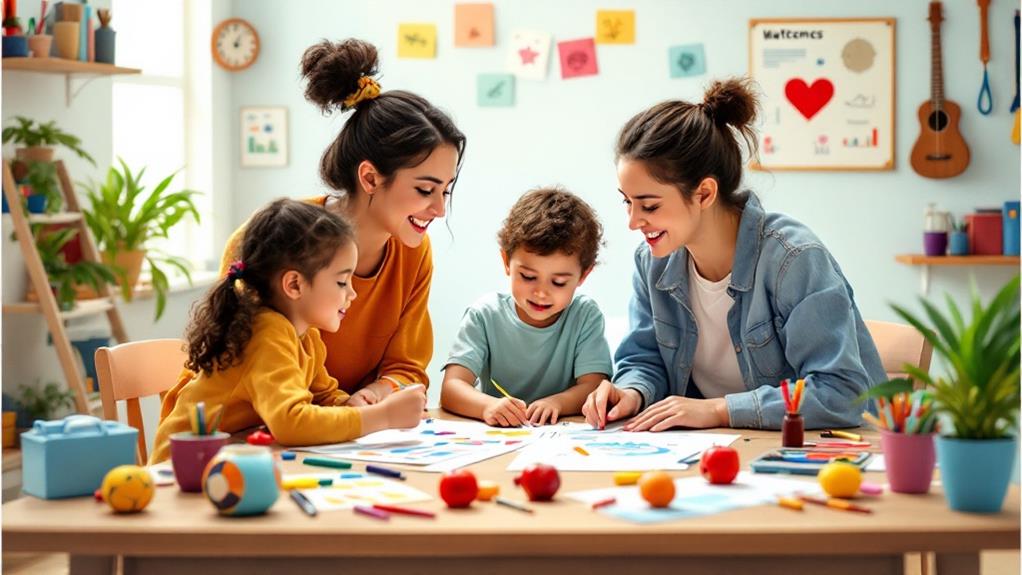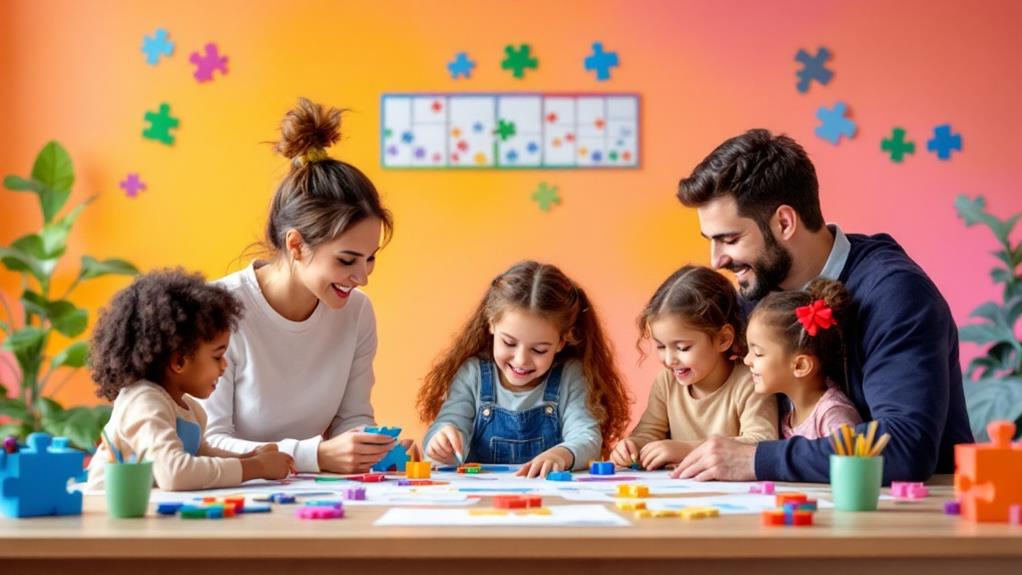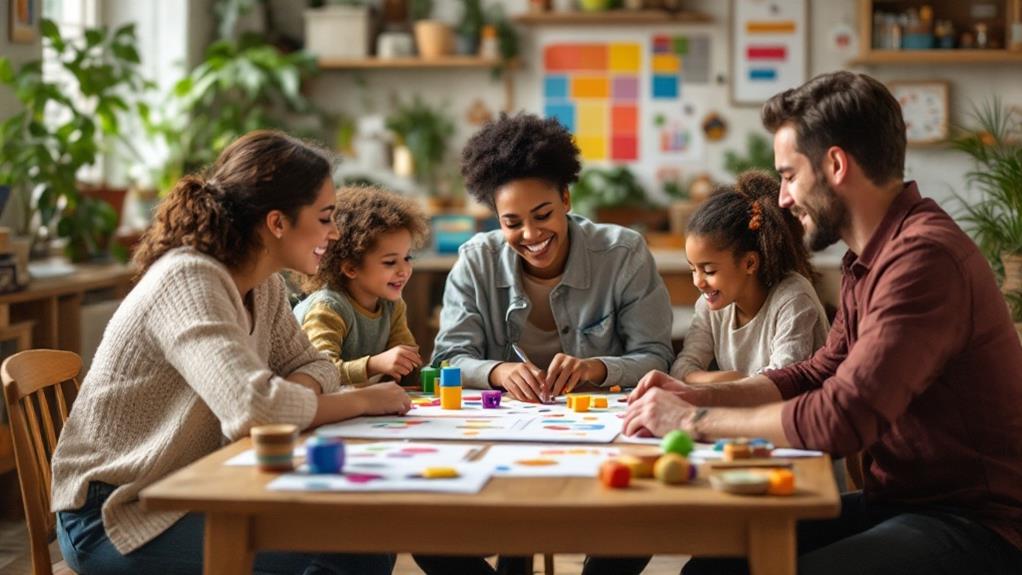Collaboration between therapists, teachers, and families creates a powerful support system for your child's growth. When everyone communicates openly and sets shared goals, it fosters a nurturing environment that encourages consistent progress. Each role brings unique insights, helping to bridge the gap between therapy and everyday learning. Regular check-ins and celebrated milestones keep spirits high and maintain focus on the child's needs. You're not just building a team; you're creating a community dedicated to your child's success. Engaging with this collaborative approach can lead to inspiring outcomes, and there's so much more to explore on this journey.
Key Takeaways
- Collaborative efforts among therapists, teachers, and families create aligned goals, fostering a unified direction for the child's development.
- Open communication builds trust and enhances understanding, ensuring everyone is informed and involved in the child's progress.
- Joint strategies and consistent techniques across home and school reinforce learning, promoting emotional and cognitive growth in the child.
- Regular check-ins and feedback loops facilitate adjustments, ensuring strategies remain effective and responsive to the child's evolving needs.
- Celebrating shared successes strengthens community bonds, motivating all parties and affirming the positive impact of teamwork on child development.
Understanding the Roles

As you navigate the complex landscape of support for children, understanding the distinct yet interconnected roles of therapists, teachers, and families becomes essential. Each player contributes a unique perspective and skill set, creating a holistic ecosystem that nurtures a child's growth.
Therapists focus on targeted interventions, addressing specific challenges a child may face. They're trained to provide strategies that empower both the child and their support network.
Teachers, on the other hand, play a pivotal role in the child's daily learning environment. They observe how children engage with their peers and curriculum, adapting techniques to foster academic and social success.
Families are the heart of this collaboration, offering love, stability, and insights into the child's needs and strengths. Your engagement and advocacy can bridge the gap between therapy and classroom learning, ensuring strategies are consistent across settings.
Building Effective Communication
Effective communication serves as the backbone of collaboration among therapists, teachers, and families. When you prioritize open dialogue, you create a space where each voice is valued, fostering trust and understanding. This trust is vital—it allows you to share insights and concerns freely, guaranteeing everyone is on the same page regarding a child's needs.
To build effective communication, start by being an active listener. When you engage with empathy, you not only hear the words but also understand the emotions behind them.
Regular check-ins are essential; whether through emails, phone calls, or meetings, consistent updates keep everyone informed and involved.
Using clear and straightforward language can prevent misunderstandings. Avoid jargon that might confuse family members or teachers. Instead, aim for clarity in your messages, expressing ideas and concerns succinctly.
Furthermore, encourage feedback. When you invite others to share their thoughts, you foster a collaborative spirit that enriches the communication process.
Establishing Common Goals

Building on the foundation of open communication, establishing common goals among therapists, teachers, and families creates a unified direction for supporting a child's development. When everyone involved aligns their efforts, it fosters a sense of teamwork that can truly empower the child.
You're not just setting objectives; you're creating a roadmap that guides daily interactions, ensuring consistency and clarity across home, school, and therapy environments.
Consider the impact of shared aspirations. When therapists, teachers, and families collaborate to define specific, measurable goals, everyone understands what success looks like. This shared vision helps you celebrate milestones together, reinforcing the child's progress.
You'll find that when each party is on the same page, it cultivates a nurturing ecosystem where the child feels supported from all angles.
Moreover, establishing common goals encourages accountability. When you commit to a unified approach, it inspires you to check in regularly, adjust strategies, and remain focused.
This collective dedication not only enhances the child's experience but also strengthens the bonds among all involved. By working together, you're not just helping a child grow; you're building a community committed to their success.
Strategies for Collaboration
Collaboration thrives on intentional strategies that bring therapists, teachers, and families together with a shared purpose.
By employing these strategies, you can cultivate an environment where everyone contributes to a child's growth and success. Here are some effective approaches to enhance collaboration:
- Regular Communication: Establish a routine for sharing updates, concerns, and progress. This could be through emails, phone calls, or scheduled meetings.
- Joint Training Sessions: Organize workshops that include all parties. This builds understanding and strengthens the bond between therapists, teachers, and families.
- Shared Resources: Create a common repository of tools, activities, and strategies that everyone can access. This guarantees everyone is on the same page and can support the child's needs effectively.
- Celebrate Successes Together: Acknowledge and celebrate milestones, big or small. This fosters a sense of unity and motivation among everyone involved.
Benefits of a Unified Approach

A unified approach can transform the way you support a child's development, creating a harmonious environment where each contributor feels valued and heard. When therapists, teachers, and families work together, they weave a consistent narrative that guides the child's growth. This alignment minimizes confusion and helps the child understand expectations, fostering a sense of security and confidence.
You'll witness improved communication as everyone shares insights and strategies. This synergy not only enhances the child's learning experience but also strengthens relationships among all parties involved. When everyone is on the same page, it cultivates trust, making it easier to address challenges collaboratively.
Moreover, a unified approach promotes holistic development. You're not just focusing on academic skills in the classroom or therapeutic goals in sessions. Instead, you're nurturing emotional, social, and cognitive growth across all settings, ensuring the child feels supported in every aspect of their life.
Ultimately, this collaborative spirit empowers you, the child, and their support network. It creates a shared vision that inspires everyone to aim for the best outcomes, reminding you that together, you can make a profound difference in the child's journey.
Case Studies of Success
Through real-life examples, you can see the profound impact of collaboration among therapists, teachers, and families. One case study involved a young boy named Ethan, who struggled with anxiety in school. His therapist, teacher, and parents met regularly to share insights and strategies, leading to noticeable improvements in Ethan's confidence and engagement.
In another scenario, a girl named Mia faced challenges with social skills. By working together, her speech therapist and classroom teacher implemented consistent strategies that helped Mia thrive socially, enabling her to form friendships and participate more actively.
These successes highlight the importance of teamwork, showcasing how a unified approach can lead to remarkable outcomes.
Consider these key elements:
- Shared Goals: Everyone involved aligns on the desired outcomes for the child.
- Open Communication: Regular updates and discussions foster trust and understanding.
- Consistent Strategies: Techniques used in therapy can be reinforced at home and school.
- Celebrating Progress: Acknowledging achievements, no matter how small, motivates everyone involved.
These examples reflect the power of collaboration, reminding you that when you unite efforts, you can create a supportive environment that nurtures growth and joy.
Overcoming Challenges Together

Facing challenges together can transform obstacles into opportunities for growth. When you collaborate with therapists, teachers, and families, you create a support system that helps everyone navigate difficulties.
Each team member brings unique insights, allowing you to approach problems from different angles. This collective wisdom not only fosters resilience but also inspires creativity in finding solutions.
Think about moments when you've faced hurdles—whether it's a child struggling with a concept in school or a therapy goal that seems out of reach.
Conclusion
Just like a symphony needs each instrument to create harmony, your collaboration as therapists, teachers, and families weaves a beautiful melody of support for your child. By uniting your strengths and perspectives, you nurture growth and resilience that echoes in every part of their life. Embrace this partnership, for together you're not just building a bridge between home, school, and therapy—you're crafting a brighter future, where every note of progress plays an essential role in their success.
